driving MITSUBISHI ECLIPSE CROSS 2020 Owner's Manual (in English)
[x] Cancel search | Manufacturer: MITSUBISHI, Model Year: 2020, Model line: ECLIPSE CROSS, Model: MITSUBISHI ECLIPSE CROSS 2020Pages: 427, PDF Size: 78.05 MB
Page 362 of 427
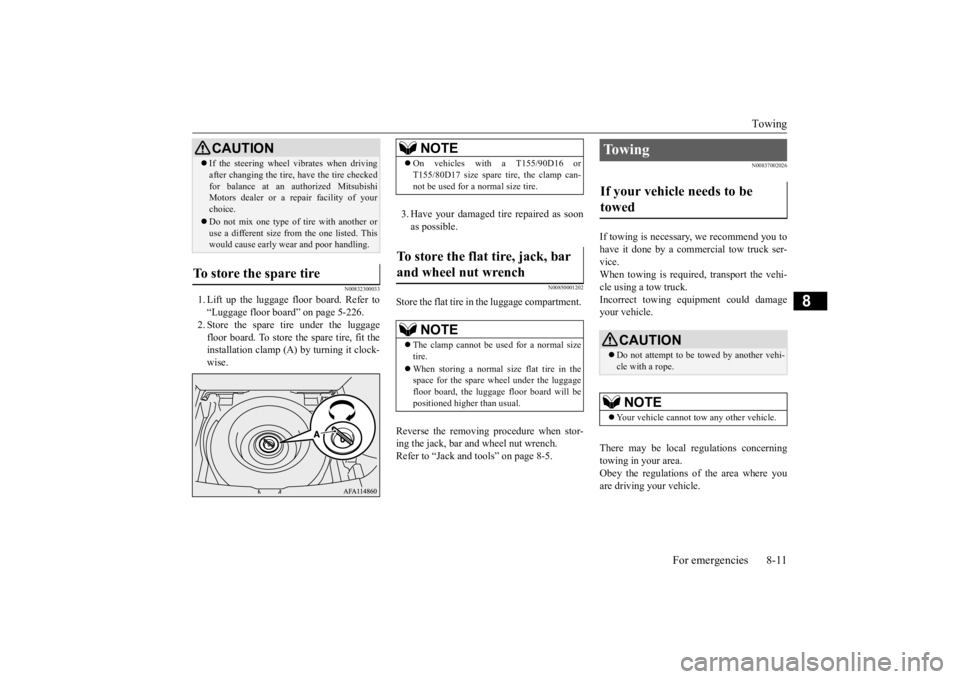
Towing
For emergencies 8-11
8
N00832300033
1. Lift up the luggage floor board. Refer to “Luggage floor board” on page 5-226. 2. Store the spare tire under the luggagefloor board. To store the spare tire, fit the installation clamp (A) by turning it clock- wise.
3. Have your damaged tire repaired as soon as possible.
N00850001202
Store the flat tire in the luggage compartment. Reverse the removing procedure when stor- ing the jack, bar and wheel nut wrench. Refer to “Jack and tools” on page 8-5.
N00837002026
If towing is necessary, we recommend you to have it done by a commercial tow truck ser- vice. When towing is required, transport the vehi-cle using a tow truck.Incorrect towing equipment could damage your vehicle. There may be local regulations concerning towing in your area. Obey the regulations of the area where you are driving your vehicle.
If the steering wheel vibrates when driving after changing the tire, have the tire checked for balance at an authorized Mitsubishi Motors dealer or a repair facility of your choice. Do not mix one type of tire with another or use a different size from the one listed. Thiswould cause early wear and poor handling.
To store the spare tire
CAUTION
NOTE
On vehicles with a T155/90D16 or T155/80D17 size spare tire, the clamp can- not be used for a normal size tire.
To store the flat tire, jack, bar and wheel nut wrench
NOTE
The clamp cannot be us
ed for a normal size
tire. When storing a normal size flat tire in the space for the spare wheel under the luggagefloor board, the luggage floor board will be positioned higher than usual.
To w i n g If your vehicle needs to be towed
CAUTION Do not attempt to be towed by another vehi- cle with a rope.NOTE
Your vehicle cannot tow any other vehicle.
BK0277700US.bo
ok 11 ページ 2019年3月8日 金曜日 午前9時23分
Page 363 of 427
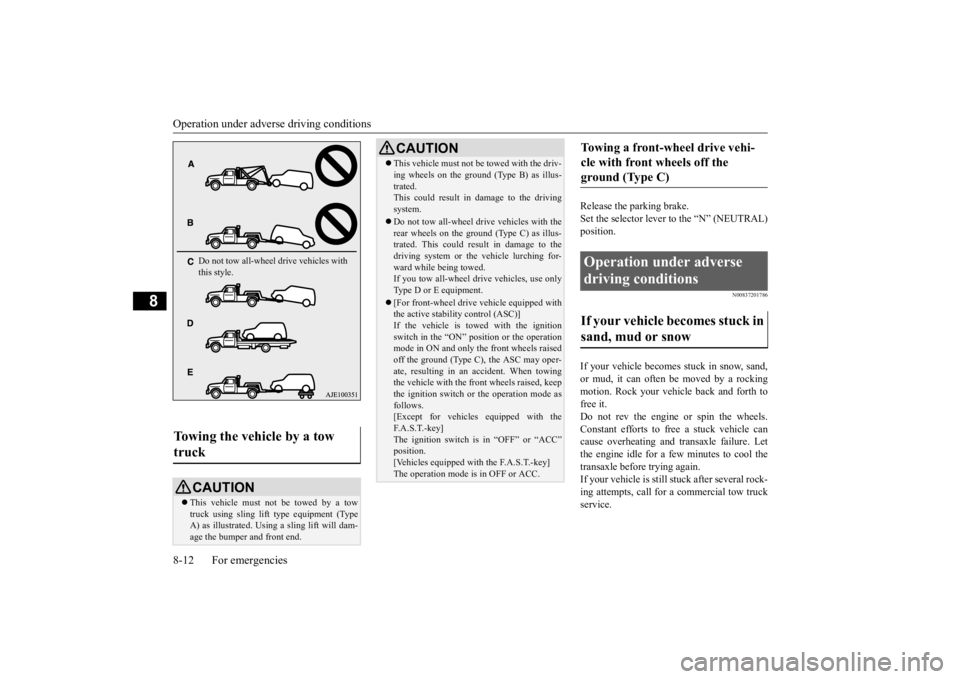
Operation under adverse driving conditions 8-12 For emergencies
8
Release the parking brake. Set the selector lever to the “N” (NEUTRAL) position.
N00837201786
If your vehicle becomes stuck in snow, sand,or mud, it can often be moved by a rocking motion. Rock your vehicle back and forth tofree it. Do not rev the engine or spin the wheels. Constant efforts to free a stuck vehicle cancause overheating and transaxle failure. Let the engine idle for a few minutes to cool the transaxle before trying again.If your vehicle is still stuck after several rock- ing attempts, call for a commercial tow truck service.
Towing the vehicle by a tow truck
CAUTION This vehicle must not be towed by a tow truck using sling lift type equipment (Type A) as illustrated. Using a sling lift will dam-age the bumper and front end.Do not tow all-wheel drive vehicles with this style.
This vehicle must not be towed with the driv- ing wheels on the ground
(Type B) as illus-
trated. This could result in damage to the driving system. Do not tow all-wheel drive vehicles with the rear wheels on the ground (Type C) as illus-trated. This could result in damage to the driving system or the vehicle lurching for- ward while being towed.If you tow all-wheel drive vehicles, use only Type D or E equipment. [For front-wheel drive vehicle equipped with the active stability control (ASC)] If the vehicle is towed with the ignitionswitch in the “ON” position or the operation mode in ON and only the front wheels raised off the ground (Type C), the ASC may oper-ate, resulting in an accident. When towing the vehicle with the front wheels raised, keep the ignition switch or the operation mode asfollows. [Except for vehicles equipped with the F. A . S . T. - k e y ]The ignition switch is in “OFF” or “ACC” position. [Vehicles equipped with the F.A.S.T.-key] The operation mode is in OFF or ACC.CAUTION
Towing a front-wheel drive vehi- cle with front wheels off the ground (Type C) Operation under adverse driving conditions If your vehicle becomes stuck in sand, mud or snow
BK0277700US.bo
ok 12 ページ 2019年3月8日 金曜日 午前9時23分
Page 364 of 427
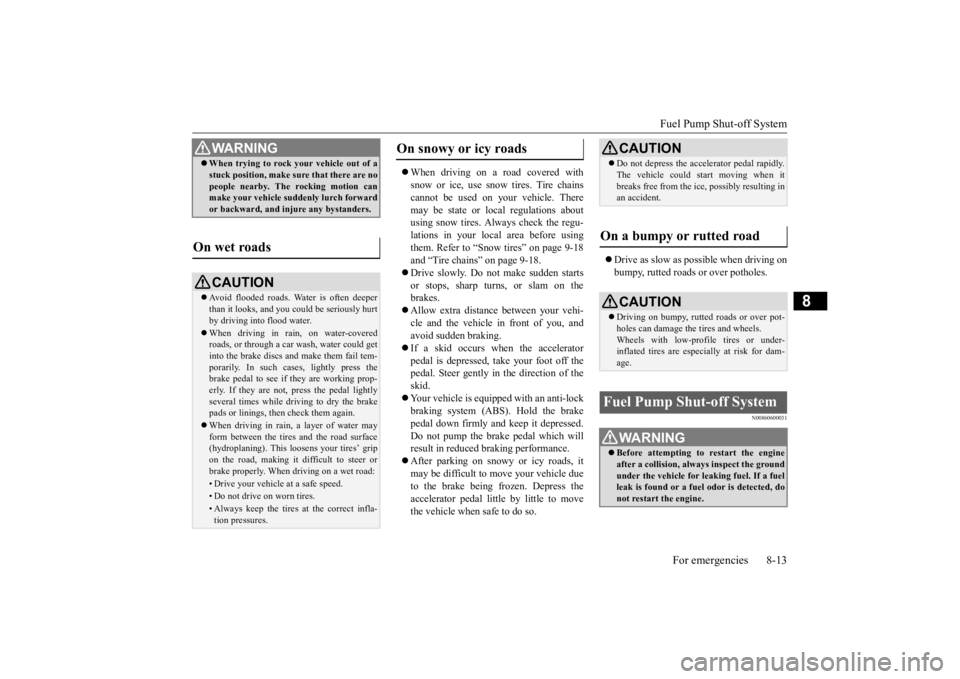
Fuel Pump Shut-off System
For emergencies 8-13
8
When driving on a road covered with snow or ice, use snow tires. Tire chains cannot be used on your vehicle. Theremay be state or local regulations about using snow tires. Always check the regu- lations in your local area before usingthem. Refer to “Snow tires” on page 9-18 and “Tire chains” on page 9-18. Drive slowly. Do not make sudden starts or stops, sharp turns, or slam on thebrakes. Allow extra distance between your vehi- cle and the vehicle in front of you, andavoid sudden braking. If a skid occurs when the accelerator pedal is depressed, take your foot off thepedal. Steer gently in the direction of the skid. Your vehicle is equipped with an anti-lock braking system (ABS). Hold the brake pedal down firmly and keep it depressed. Do not pump the brake pedal which willresult in reduced braking performance. After parking on snowy or icy roads, it may be difficult to move your vehicle dueto the brake being frozen. Depress the accelerator pedal little by little to move the vehicle when safe to do so.
Drive as slow as poss
ible when driving on
bumpy, rutted roads or over potholes.
N00860600031
WA R N I N G When trying to rock your vehicle out of a stuck position, make sure that there are no people nearby. The rocking motion can make your vehicle suddenly lurch forward or backward, and injure any bystanders.
On wet roads
CAUTION Avoid flooded roads. Water is often deeper than it looks, and you could be seriously hurt by driving into flood water. When driving in rain, on water-covered roads, or through a car wash, water could getinto the brake discs and make them fail tem- porarily. In such cases, lightly press the brake pedal to see if they are working prop-erly. If they are not, press the pedal lightly several times while driving to dry the brake pads or linings, then check them again. When driving in rain, a layer of water may form between the tires and the road surface(hydroplaning). This loosens your tires’ grip on the road, making it difficult to steer or brake properly. When driving on a wet road:• Drive your vehicle at a safe speed.• Do not drive on worn tires.• Always keep the tires at the correct infla- tion pressures.
On snowy or icy roads
CAUTION Do not depress the accelerator pedal rapidly. The vehicle could start moving when it breaks free from the ice, possibly resulting in an accident.
On a bumpy or rutted road
CAUTION Driving on bumpy, rutted roads or over pot- holes can damage the tires and wheels. Wheels with low-profile tires or under- inflated tires are especially at risk for dam-age.
Fuel Pump Shut-off System
WA R N I N G Before attempting to restart the engine after a collision, always inspect the ground under the vehicle for leaking fuel. If a fuel leak is found or a fuel odor is detected, donot restart the engine.
BK0277700US.bo
ok 13 ページ 2019年3月8日 金曜日 午前9時23分
Page 368 of 427
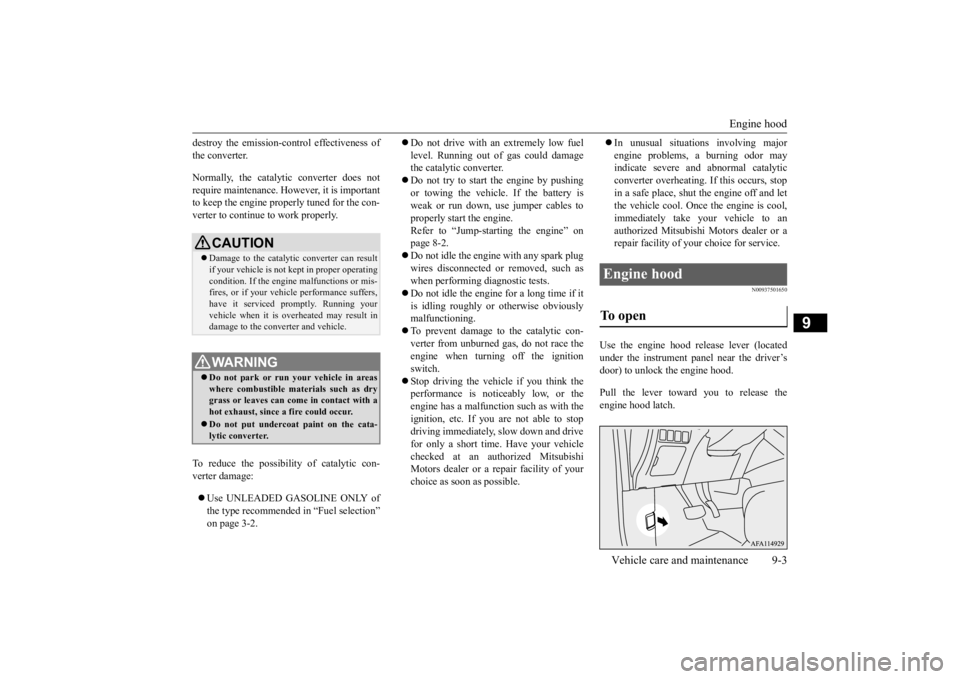
Engine hood
Vehicle care and maintenance 9-3
9
destroy the emission-control effectiveness of the converter. Normally, the catalytic converter does not require maintenance. However, it is important to keep the engine properly tuned for the con-verter to continue to work properly. To reduce the possibility of catalytic con- verter damage: Use UNLEADED GASOLINE ONLY of the type recommended in “Fuel selection” on page 3-2.
Do not drive with an extremely low fuel level. Running out of gas could damage the catalytic converter. Do not try to start the engine by pushing or towing the vehicle. If the battery is weak or run down, use jumper cables to properly start the engine.Refer to “Jump-starting the engine” on page 8-2. Do not idle the engine with any spark plug wires disconnected or removed, such aswhen performing diagnostic tests. Do not idle the engine for a long time if it is idling roughly or otherwise obviouslymalfunctioning. To prevent damage to the catalytic con- verter from unburned gas, do not race theengine when turning off the ignition switch. Stop driving the vehicle if you think the performance is noticeably low, or the engine has a malfunction such as with the ignition, etc. If you
are not able to stop
driving immediately, slow down and drive for only a short time. Have your vehicle checked at an authorized MitsubishiMotors dealer or a repair facility of your choice as soon as possible.
In unusual situations involving major engine problems, a burning odor may indicate severe and abnormal catalytic converter overheating. If this occurs, stopin a safe place, shut the engine off and let the vehicle cool. Once the engine is cool, immediately take your vehicle to anauthorized Mitsubishi Motors dealer or a repair facility of your choice for service.
N00937501650
Use the engine hood release lever (located under the instrument panel near the driver’s door) to unlock the engine hood. Pull the lever toward you to release the engine hood latch.
CAUTION Damage to the catalytic converter can result if your vehicle is not kept in proper operating condition. If the engine malfunctions or mis-fires, or if your vehicle performance suffers, have it serviced promptly. Running your vehicle when it is overheated may result indamage to the converter and vehicle.WA R N I N G Do not park or run your vehicle in areas where combustible materials such as drygrass or leaves can come in contact with a hot exhaust, since a fire could occur. Do not put undercoat paint on the cata- lytic converter.
Engine hood To open
BK0277700US.bo
ok 3 ページ 2019年3月8日 金曜日 午前9時23分
Page 369 of 427
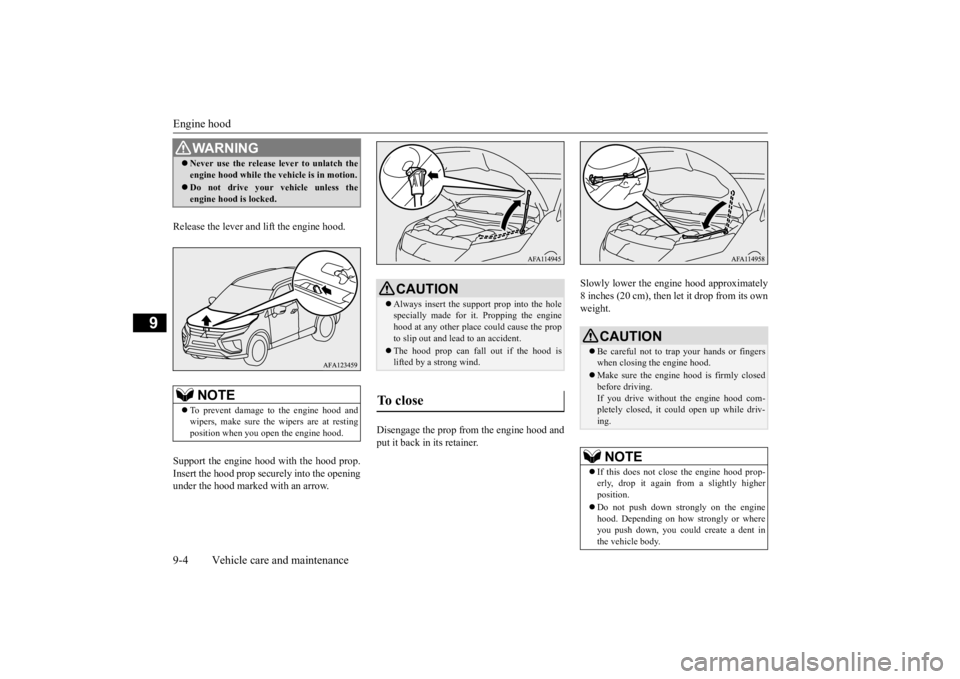
Engine hood 9-4 Vehicle care and maintenance
9
Release the lever and lift the engine hood. Support the engine hood with the hood prop. Insert the hood prop secu
rely into the opening
under the hood marked with an arrow.
Disengage the prop from the engine hood and put it back in its retainer.
Slowly lower the engine hood approximately 8 inches (20 cm), then let it drop from its ownweight.
WA R N I N G Never use the release lever to unlatch the engine hood while the vehicle is in motion. Do not drive your vehicle unless the engine hood is locked.NOTE
To prevent damage to the engine hood and wipers, make sure the wipers are at resting position when you open the engine hood.
CAUTION Always insert the support prop into the hole specially made for it. Propping the engine hood at any other place could cause the prop to slip out and lead to an accident. The hood prop can fall out if the hood is lifted by a strong wind.
To close
CAUTION Be careful not to trap your hands or fingers when closing the engine hood. Make sure the engine hood is firmly closed before driving. If you drive without the engine hood com-pletely closed, it could open up while driv- ing.NOTE
If this does not close the engine hood prop- erly, drop it again from a slightly higher position. Do not push down strongly on the engine hood. Depending on how strongly or where you push down, you could create a dent inthe vehicle body.
BK0277700US.bo
ok 4 ページ 2019年3月8日 金曜日 午前9時23分
Page 371 of 427
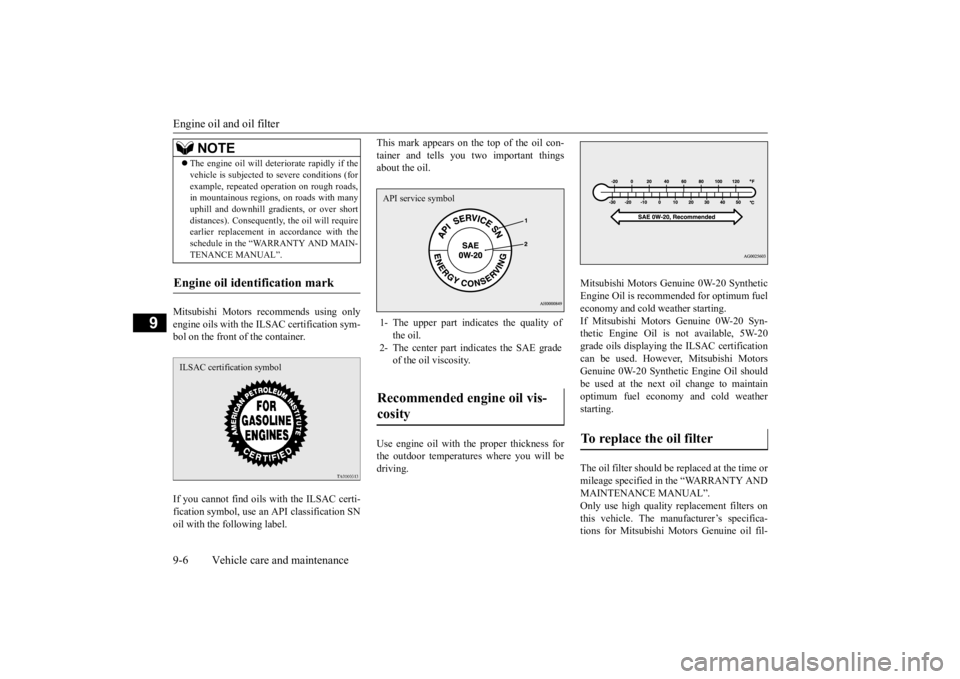
Engine oil and oil filter 9-6 Vehicle care and maintenance
9
Mitsubishi Motors recommends using only engine oils with the ILSAC certification sym- bol on the front of the container. If you cannot find oils with the ILSAC certi- fication symbol, use an API classification SN oil with the following label.
This mark appears on the top of the oil con- tainer and tells you two important things about the oil. Use engine oil with the proper thickness for the outdoor temperatures where you will bedriving.
Mitsubishi Motors Ge
nuine 0W-20 Synthetic
Engine Oil is recommended for optimum fuel economy and cold weather starting.If Mitsubishi Motors Genuine 0W-20 Syn- thetic Engine Oil is
not available, 5W-20
grade oils displaying the ILSAC certificationcan be used. However, Mitsubishi Motors Genuine 0W-20 Synthetic Engine Oil should be used at the next oil change to maintainoptimum fuel economy and cold weatherstarting. The oil filter should be
replaced at the time or
mileage specified in the “WARRANTY AND MAINTENANCE MANUAL”. Only use high quality replacement filters onthis vehicle. The manufacturer’s specifica- tions for Mitsubishi Motors Genuine oil fil-
The engine oil will deteriorate rapidly if the vehicle is subjected to severe conditions (for example, repeated operation on rough roads, in mountainous regions, on roads with many uphill and downhill gradients, or over shortdistances). Consequently, the oil will require earlier replacement in accordance with the schedule in the “WARRANTY AND MAIN-TENANCE MANUAL”.
Engine oil identification mark
NOTE
ILSAC certification symbol
1- The upper part indicates the quality of
the oil.
2- The center part indicates the SAE grade
of the oil viscosity.
Recommended engine oil vis- cosity API service symbol
To replace the oil filter
BK0277700US.bo
ok 6 ページ 2019年3月8日 金曜日 午前9時23分
Page 375 of 427
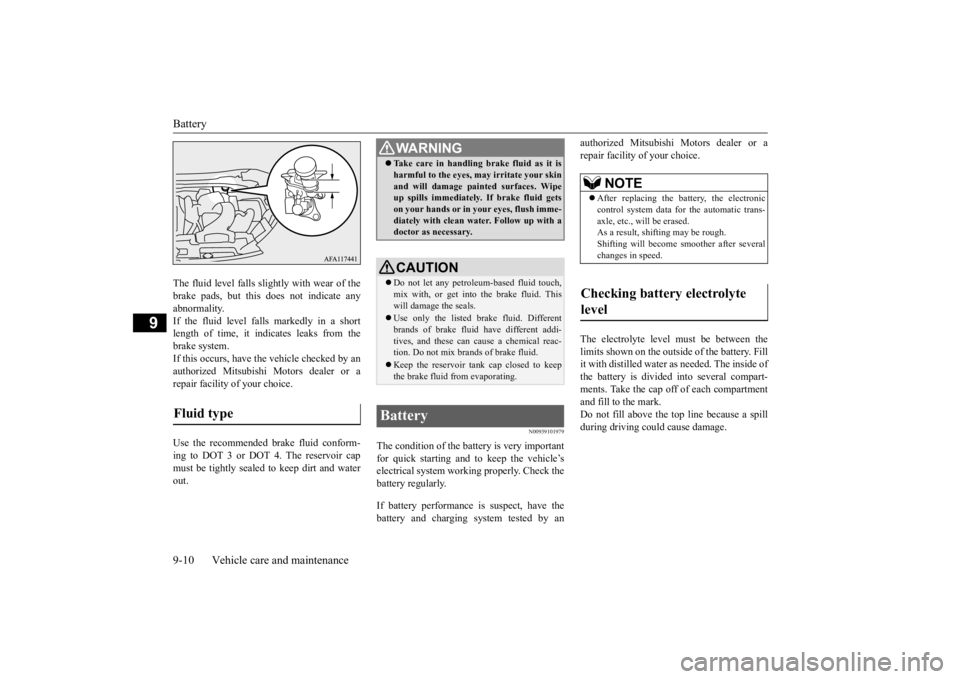
Battery 9-10 Vehicle care and maintenance
9
The fluid level falls slightly with wear of the brake pads, but this does not indicate anyabnormality. If the fluid level falls markedly in a short length of time, it indicates leaks from thebrake system. If this occurs, have the vehicle checked by an authorized Mitsubishi Motors dealer or arepair facility of your choice. Use the recommended brake fluid conform- ing to DOT 3 or DOT 4. The reservoir capmust be tightly sealed to keep dirt and water out.
N00939101979
The condition of the battery is very important for quick starting and to keep the vehicle’selectrical system working properly. Check the battery regularly. If battery performance is suspect, have the battery and charging system tested by an
authorized Mitsubishi Motors dealer or a repair facility of your choice. The electrolyte level must be between the limits shown on the outside of the battery. Fill it with distilled water as needed. The inside ofthe battery is divided into several compart- ments. Take the cap off of each compartment and fill to the mark.Do not fill above the top line because a spill during driving could cause damage.
Fluid type
WA R N I N G Take care in handling brake fluid as it is harmful to the eyes, may irritate your skin and will damage painted surfaces. Wipe up spills immediately. If brake fluid gets on your hands or in your eyes, flush imme-diately with clean water. Follow up with a doctor as necessary.CAUTION Do not let any petroleum-based fluid touch, mix with, or get into the brake fluid. This will damage the seals. Use only the listed brake fluid. Different brands of brake fluid have different addi- tives, and these can cause a chemical reac-tion. Do not mix brands of brake fluid. Keep the reservoir tank cap closed to keep the brake fluid from evaporating.
Battery
NOTE
After replacing the battery, the electronic control system data for the automatic trans- axle, etc., will be erased.As a result, shifting may be rough. Shifting will become smoother after several changes in speed.
Checking battery electrolyte level
BK0277700US.bo
ok 10 ページ 2019年3月8日 金曜日 午前9時23分
Page 377 of 427
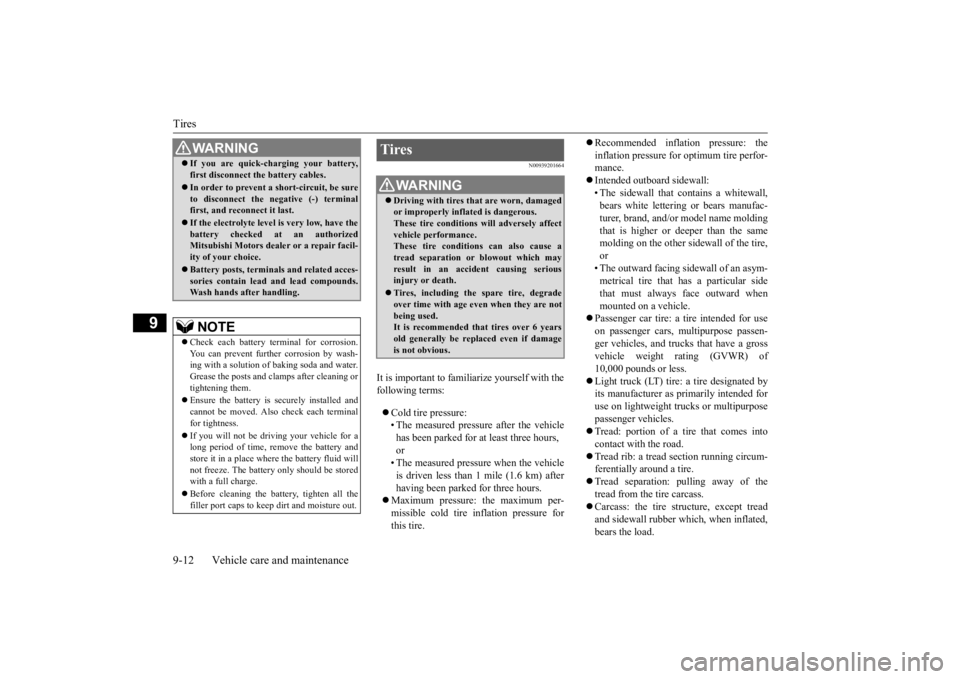
Tires 9-12 Vehicle care and maintenance
9
N00939201664
It is important to familiarize yourself with the following terms: Cold tire pressure: • The measured pressure after the vehicle has been parked for at least three hours,or • The measured pressure when the vehicle is driven less than 1 mile (1.6 km) afterhaving been parked for three hours.
Maximum pressure: the maximum per- missible cold tire inflation pressure forthis tire.
Recommended inflation pressure: the inflation pressure for optimum tire perfor- mance. Intended outboard sidewall: • The sidewall that contains a whitewall, bears white lettering or bears manufac- turer, brand, and/or model name moldingthat is higher or deeper than the same molding on the other sidewall of the tire, or• The outward facing sidewall of an asym-metrical tire that has a particular side that must always face outward when mounted on a vehicle.
Passenger car tire: a tire intended for use on passenger cars,
multipurpose passen-
ger vehicles, and trucks that have a grossvehicle weight rating (GVWR) of 10,000 pounds or less. Light truck (LT) tire: a tire designated by its manufacturer as primarily intended for use on lightweight trucks or multipurpose passenger vehicles. Tread: portion of a tire that comes into contact with the road. Tread rib: a tread section running circum- ferentially around a tire. Tread separation: pulling away of the tread from the tire carcass. Carcass: the tire structure, except tread and sidewall rubber which, when inflated, bears the load.
If you are quick-charging your battery, first disconnect the battery cables. In order to prevent a short-circuit, be sure to disconnect the negative (-) terminalfirst, and reconnect it last. If the electrolyte level is very low, have the battery checked at an authorized Mitsubishi Motors dealer or a repair facil- ity of your choice. Battery posts, terminals and related acces- sories contain lead and lead compounds.Wash hands after handling.NOTE
Check each battery terminal for corrosion. You can prevent further corrosion by wash- ing with a solution of baking soda and water.Grease the posts and clamps after cleaning or tightening them. Ensure the battery is securely installed and cannot be moved. Also check each terminal for tightness. If you will not be driv
ing your vehicle for a
long period of time, remove the battery and store it in a place where the battery fluid will not freeze. The battery only should be storedwith a full charge. Before cleaning the battery, tighten all the filler port caps to keep dirt and moisture out.WA R N I N G
Tires
WA R N I N G Driving with tires that are worn, damaged or improperly inflated is dangerous. These tire conditions will adversely affect vehicle performance.These tire conditions can also cause a tread separation or blowout which may result in an accident causing seriousinjury or death. Tires, including the spare tire, degrade over time with age even when they are not being used. It is recommended that tires over 6 yearsold generally be replaced even if damage is not obvious.
BK0277700US.bo
ok 12 ページ 2019年3月8日 金曜日 午前9時23分
Page 380 of 427

Tires
Vehicle care and maintenance 9-15
9
EXAMPLE: DOT MA L9 ABCD 1504
The treadwear grade is a comparative rating based on the wear rate of the tire when tested under controlled conditions on a specified government test course. For example, a tiregraded 150 would wear one and one-half (11/2) times as well on the government course
as a tire graded 100. The relative performance of tires depends upon the actual conditions oftheir use, however, and may depart signifi- cantly from the norm due to variations in driving habits, service practices and differ-ences in road characteristics and climate. The traction grades, from highest to lowest, are AA, A, B and C. Those grades represent the tire’s ability to stop on wet pavement asmeasured under controlled conditions on specified government test surfaces of asphalt and concrete. A tire marked C may have poortraction performance.
The temperature grades are A (the highest), B and C, representing the tire’s resistance to the generation of heat and its ability to dissipate heat when tested under controlled conditionson a specified indoor laboratory test wheel. Sustained high temperature can cause the material of the tire to degenerate and reducetire life, and excessive temperature can lead to sudden tire failure. The grade C corre- sponds to a level of performance which allpassenger car tires must meet under the Fed-eral Motor Vehicle Safety Standard No. 109. Grades B and A represent higher levels of performance on the laboratory test wheel thanthe minimum required by law.
N00939302008
Proper tire inflation pressure is essential forthe safe and satisfactory operation of your vehicle. The wrong tire pressure will cause problems in three major areas: Safety Too little pressure increases flexing in the tire and can cause tire failure. Too much pressure can cause a tire to lose its abilityto cushion shock. Objects on the road and potholes could then cause tire damage that may result in tire failure.
DOT
Department of Transporta- tion This symbol certifies that the tire is in compliance with the U.S. Department of Trans- portation tire safety stan-dards, and is approved for highway use.
MA
Code representing the tire manufacturing location. (2 digits)
L9 ABC D
Code representing the tire size. (2 digits)Code used by tire manufac- turer. (1 to 4 digits)
15
Number representing the week in which the tire was manufactured. (2 digits)
04
Number representing the year in which the tire was manufactured. (2 digits)
Treadwear, Traction and Temper- ature Grades Treadwear Traction
TemperatureTire inflation pressures
BK0277700US.bo
ok 15 ページ 2019年3月8日 金曜日 午前9時23分
Page 381 of 427
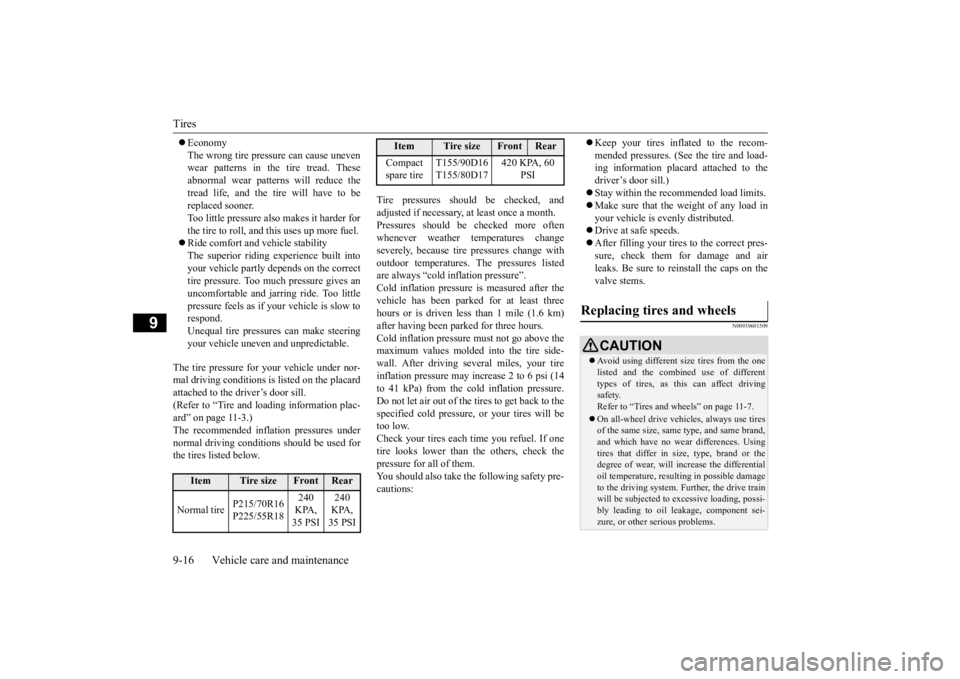
Tires 9-16 Vehicle care and maintenance
9
Economy The wrong tire pressure can cause uneven wear patterns in the tire tread. These abnormal wear patterns will reduce thetread life, and the tire will have to be replaced sooner. Too little pressure also makes it harder forthe tire to roll, and this uses up more fuel. Ride comfort and vehicle stability The superior riding experience built intoyour vehicle partly depends on the correcttire pressure. Too much pressure gives an uncomfortable and jarring ride. Too little pressure feels as if your vehicle is slow torespond. Unequal tire pressures can make steering your vehicle uneven and unpredictable.
The tire pressure for your vehicle under nor- mal driving conditions is listed on the placard attached to the driver’s door sill. (Refer to “Tire and loading information plac-ard” on page 11-3.) The recommended infl
ation pressures under
normal driving conditions should be used forthe tires listed below.
Tire pressures should be checked, and adjusted if necessary, at least once a month. Pressures should be checked more often whenever weather temperatures changeseverely, because tire pressures change with outdoor temperatures. The pressures listed are always “cold inflation pressure”.Cold inflation pressure is measured after the vehicle has been parked for at least three hours or is driven less than 1 mile (1.6 km)after having been parked for three hours.Cold inflation pressure must not go above the maximum values molded into the tire side- wall. After driving several miles, your tireinflation pressure may increase 2 to 6 psi (14 to 41 kPa) from the cold inflation pressure. Do not let air out of the tires to get back to thespecified cold pressure, or your tires will be too low. Check your tires each time you refuel. If onetire looks lower than the others, check the pressure for all of them. You should also take the following safety pre-cautions:
Keep your tires inflated to the recom- mended pressures. (See the tire and load- ing information placard attached to the driver’s door sill.) Stay within the recommended load limits. Make sure that the weight of any load in your vehicle is evenly distributed. Drive at safe speeds. After filling your tires to the correct pres- sure, check them for damage and airleaks. Be sure to reinstall the caps on thevalve stems.
N00939601509
Item
Tire size
Front
Rear
Normal tire
P215/70R16 P225/55R18
240 KPA, 35 PSI
240 KPA, 35 PSI
Compact spare tire
T155/90D16 T155/80D17
420 KPA, 60
PSI
Item
Tire size
Front
Rear
Replacing tires and wheels
CAUTION Avoid using different si
ze tires from the one
listed and the combined use of different types of tires, as this can affect drivingsafety. Refer to “Tires and wheels” on page 11-7. On all-wheel drive vehicles, always use tires of the same size, same type, and same brand, and which have no wear differences. Usingtires that differ in size, type, brand or the degree of wear, will increase the differential oil temperature, resulting in possible damage to the driving system. Further, the drive train will be subjected to excessive loading, possi-bly leading to oil leakage, component sei- zure, or other serious problems.
BK0277700US.bo
ok 16 ページ 2019年3月8日 金曜日 午前9時23分